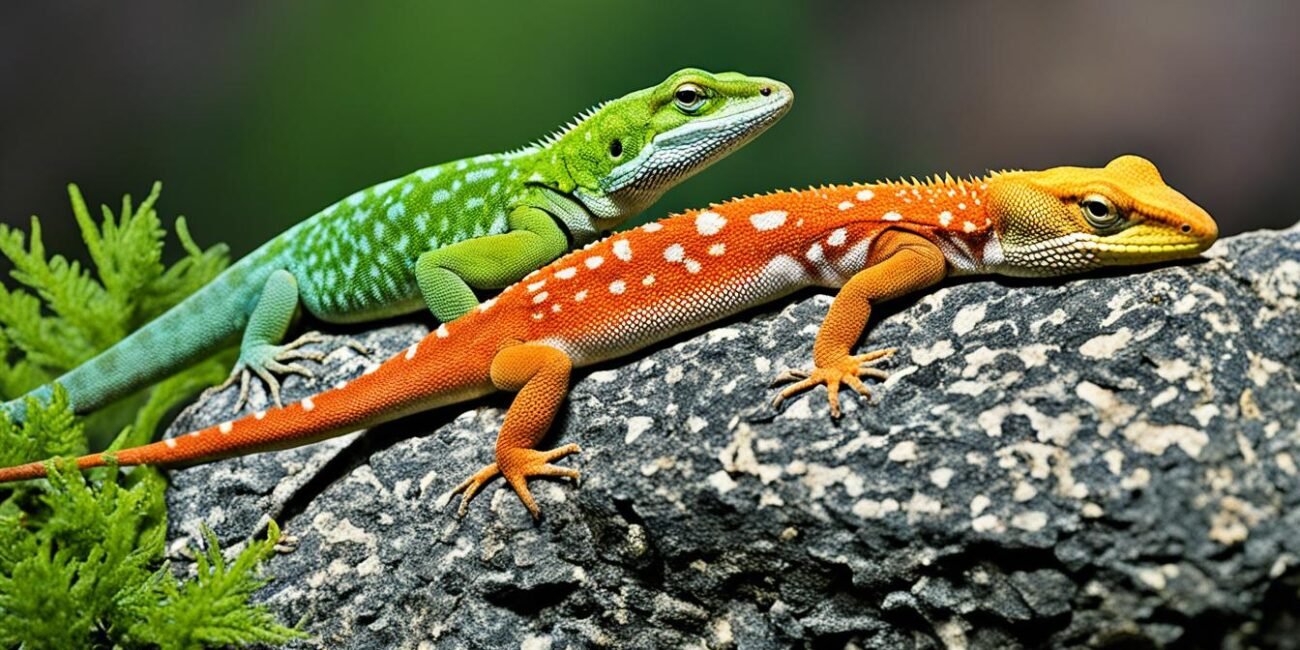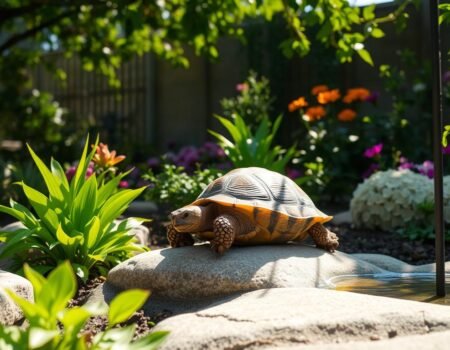Choosing a pet is an exciting endeavor, but finding the perfect fit for your lifestyle can sometimes feel like searching for a needle in a haystack. My partner and I recently found ourselves in this predicament, looking for an ideal pet to add to our household.
After months of research and contemplation, we stumbled upon a fascinating world that we had never considered before – lizards. These incredible creatures offer a unique charm and captivating beauty that immediately piqued our interest. We delved into a journey of discovery, learning about different lizard species, their care requirements, and their compatibility with varying households.
In this comprehensive guide, we aim to share our newfound knowledge with you. Whether you’re a reptile enthusiast or just exploring the idea of having a lizard as a pet, we’re here to help you navigate the world of lizards and find the perfect companion for your home. From sharing the top choices for pet lizards to providing essential care tips and handling techniques, we’ve got you covered.
So, let’s embark on this lizard-filled adventure together and discover the world of ideal pet lizards!
Understanding Pet Lizard Temperament and Compatibility
Understanding the temperament of pet lizards is essential when choosing a lizard that will fit well in your household. Let’s explore what it truly means for a lizard to be calm and friendly, dispelling common misconceptions and providing insights into their behavior.
It is important to consider the social dynamics of lizards to ensure a harmonious environment within your home. Lizards have their unique ways of interacting and establishing hierarchies, just like any other social animal. By understanding their social dynamics, you can create a peaceful and welcoming space for your pet lizard.
When it comes to pet lizard temperament, it’s crucial to remember that reptiles have their own distinct personality traits. While some lizards may be naturally more calm and sociable, others may exhibit shyness or even aggression. It’s important to observe and understand individual behaviors to determine the best fit for your household.
Many potential lizard owners may assume that a “friendly” lizard is the one that loves to be handled or craves constant attention. However, it’s essential to recognize that lizards have different comfort levels with handling, and their friendliness can manifest in various ways. Some lizards may enjoy being handled and easily adapt to interaction, while others may prefer observing from a distance.
In order to establish a harmonious household, it’s crucial to consider the unique social dynamics of lizards. Some lizard species thrive in solitary environments, while others can be housed together peacefully. It’s important to research and understand the social behavior and compatibility of different lizard species to ensure a healthy and stress-free living environment.
| Lizard Behavior | Social Dynamics and Compatibility |
|---|---|
| Varies by species and individual | Different social needs and behaviors |
| Some lizards are naturally more calm and sociable | Species that can be housed together peacefully |
| Others may exhibit shyness or aggression | Species that prefer solitary environments |
| Lizard behavior cannot be generalized | Research and understand social behaviors of specific species |
Caring for Your Pet Lizard: Vital Habitat Requirements
Creating a suitable habitat is crucial for the overall health and well-being of your pet lizard. By understanding and meeting their habitat requirements, you can provide a comfortable and thriving environment for your scaly friend. Let’s explore the key factors to consider when setting up your pet lizard’s habitat.
1. Enclosure Size and Type: Selecting the right enclosure is essential to ensure your pet lizard has enough space to roam and feel secure. The size of the enclosure will depend on the species of lizard you have. Research the specific requirements for your lizard to determine the appropriate enclosure dimensions and type.
2. Substrate: The substrate in your lizard’s enclosure serves multiple purposes, including providing a comfortable surface for them to move on, aiding in maintaining humidity levels, and facilitating natural behaviors like burrowing. Choose a substrate that is appropriate for your lizard’s specific needs, such as reptile carpet, coconut husk, or sand.
3. Temperature and Humidity Control: Lizards are ectothermic, meaning they rely on external heat sources to regulate their body temperature. It’s crucial to create a temperature gradient within the enclosure, with a warm side for basking and a cooler side for retreat. Use thermometers and heat sources like heat lamps or heat mats to maintain the proper temperature range for your lizard. In addition, monitor and regulate humidity levels to ensure they are within the recommended range for your species of lizard.
4. Lighting: Adequate lighting is essential for the health of your pet lizard. They require exposure to UVA and UVB rays to stimulate Vitamin D3 synthesis, which aids in calcium absorption and overall bone health. Provide full-spectrum lighting by using reptile-specific UVB bulbs and ensure they are replaced according to the manufacturer’s recommendations.
5. Proper Hiding Spots: Creating hiding spots within the enclosure is crucial for your lizard’s sense of security. Use rocks, logs, or artificial hideouts to provide areas where they can retreat and feel safe. These hiding spots also serve as opportunities for natural behaviors like basking or shedding.
By carefully considering and meeting these vital habitat requirements, you can create an environment that promotes the physical and mental well-being of your pet lizard. Remember to research the specific needs of your lizard species and regularly assess and adjust the habitat to ensure it remains suitable for your scaly companion.
Choosing a Beginner Pet Lizard for a Positive Experience
As a novice lizard owner, selecting the right pet lizard is essential to ensure a successful and enjoyable journey into the world of reptile keeping. There are several factors to consider when choosing a lizard as a beginner, including ease of care, temperament, and handling ability.
Best Lizard as a Pet: Factors to Consider for Novice Owners
When evaluating lizards for beginner pet owners, it is important to look for species that are known for their beginner-friendly nature. These lizards are typically easier to care for and handle, making them ideal for first-time reptile keepers.
Some key factors to consider when selecting a lizard as a novice owner include:
- Size: Opt for smaller lizards that are easier to handle and require less space.
- Temperament: Look for calm and docile lizards that are less likely to exhibit aggressive behavior.
- Care requirements: Choose lizards that have relatively simple care needs, such as moderate temperature and humidity requirements.
- Availability: Consider lizards that are readily available from reputable sources, ensuring easier access to proper care information and resources.
Top Pet Lizards for First-Time Keepers
For first-time reptile keepers, several lizards are highly recommended due to their ease of care and beginner-friendly nature. These lizards have proven to be popular choices among novice lizard owners:
- Leopard Gecko (Eublepharis macularius): Known for their gentle nature, leopard geckos are great options for beginners. They are relatively low maintenance and come in various colorful morphs.
- Crested Gecko (Correlophus ciliatus): These arboreal lizards are renowned for their docile temperament and ease of care. They are mostly nocturnal and thrive in a tropical setup.
- Bearded Dragon (Pogona vitticeps): Bearded dragons are sociable lizards that enjoy interaction with their owners. They have relatively simple care requirements and are highly adaptable to different environments.
- Blue-Tongued Skink (Tiliqua spp.): With their unique blue tongues and mellow personalities, blue-tongued skinks are popular choices for beginners. They have a varied diet and require a larger enclosure.
- Anoles (Anolis spp.): Anoles are small and active lizards that can be a delightful addition to a beginner’s collection. They require relatively simple care and thrive in a tropical setup.
Creating the Ideal Setting for Your First Lizard Friend
Setting up the perfect environment for your first lizard is crucial for their well-being and happiness. Here are some key steps to consider when setting up your first lizard enclosure:
- Enclosure: Choose an appropriate-sized enclosure based on the species’ adult size, ensuring enough space for your lizard to move and explore.
- Substrate: Select a suitable substrate that provides a natural and comfortable surface for your lizard to walk on, such as reptile carpet or coconut fiber.
- Temperature and humidity: Install a heat source and a hygrometer to maintain optimal temperature and humidity levels within the enclosure, suiting the specific needs of your chosen lizard species.
- Lighting: Provide proper UVB lighting to facilitate your lizard’s calcium metabolism and overall well-being.
- Hiding spots and decorations: Include various hiding spots, such as logs, rocks, or plants, to offer your lizard privacy and enrichment in their enclosure.
- Feeding and water dishes: Place appropriate-sized dishes for food and water in the enclosure, ensuring easy access for your lizard.
By considering these factors and following proper husbandry practices, you can create the ideal setting for your first lizard friend, setting the stage for a rewarding and positive reptile-keeping experience.
Exotic Pet Lizard Overview: Species That Steal the Show
If you’re looking for an exotic pet lizard that stands out from the crowd, this section is for you. We will provide an overview of some of the most captivating and unique lizard species available as pets, highlighting their distinct characteristics, care requirements, and suitability for experienced reptile keepers. Discover the world of exotic pet lizards and find the perfect showstopper for your home.
Exotic pet lizards are a captivating addition to any reptile enthusiast’s collection. These unique lizard species boast striking colors, distinctive patterns, and fascinating behaviors, making them true showstoppers. However, it’s important to note that exotic pet lizards require experienced handlers who are well-versed in reptile care.
One example of an exotic pet lizard is the Chinese Water Dragon. Known for its vibrant green color and its ability to live near water, this lizard species thrives in tropical environments. Its long tail and impressive agility make it a visually stunning reptile to observe and interact with.
Another remarkable exotic pet lizard is the Panther Chameleon. These lizards are known for their ability to change colors, creating a mesmerizing display that will surely impress any observer. With their unique color patterns and their striking horn-like protrusions on their heads, they are definitely a breed apart.
For those seeking a rare and exotic lizard species, the Frilled Dragon is an excellent choice. These lizards have a distinctive frill around their neck that they use as a defense mechanism, making them a visually dramatic creature to own and care for.
These are just a few examples of the incredible diversity of exotic pet lizards. As with any pet, it’s essential to thoroughly research and understand the specific care requirements of each species before bringing one into your home. By providing the right habitat, diet, and attention to their unique needs, you can ensure that these beautiful reptiles thrive in your care.
Feeding Your Lizard: Nutritional Needs for Optimal Health
The Essentials of a Pet Lizard Diet
Proper nutrition is crucial for maintaining the optimal health and well-being of your pet lizard. A well-balanced diet provides the necessary nutrients to support their growth, development, and overall vitality. When it comes to feeding your lizard, it’s important to understand the essentials of their diet.
Firstly, most pet lizards are insectivores, meaning they primarily consume insects as their main source of food. This diet should consist of a variety of insects such as crickets, mealworms, and roaches. These insects provide essential proteins and fats that are vital for your lizard’s health.
In addition to insects, some lizard species also benefit from incorporating fruits and vegetables into their diet. These provide important vitamins and minerals that contribute to their overall nutrition. Leafy greens like kale, collard greens, and dandelion greens are excellent choices for supplementing their diet.
Furthermore, it’s essential to ensure that your pet lizard receives appropriate supplementation. Calcium and vitamin D3 supplements are particularly important for reptiles, as they aid in bone development and prevent metabolic bone disease.
Remember to provide fresh, clean water at all times for your lizard to stay hydrated. Some species may also benefit from occasional misting to maintain optimal humidity levels.
Consulting with a reptile veterinarian or a knowledgeable pet store professional can help you determine the specific dietary needs of your pet lizard based on their species and age.
Feeding Schedules and Dietary Variations Across Species
Feeding schedules for pet lizards can vary depending on their species, size, and age. It’s essential to establish a regular feeding routine to ensure their nutritional needs are met.
Younger lizards generally require more frequent feedings, usually once or twice a day. As they grow older, the frequency of feedings can decrease to once every other day or even once or twice a week, depending on the species.
It’s important to note that some lizard species have specific dietary requirements and dietary restrictions. For example, herbivorous species have a diet primarily composed of fruits, vegetables, and leafy greens. On the other hand, insectivorous species rely solely on insects for their nutrition.
When it comes to feeding your lizard, it’s crucial to research and understand their specific dietary needs. This knowledge ensures you provide a suitable diet that supports their optimal health and well-being.
Refer to the table below for a summary of common pet lizard species, their dietary preferences, and feeding schedule recommendations:
| Lizard Species | Diet Type | Feeding Schedule |
|---|---|---|
| Bearded Dragon | Omnivorous (Insects, Vegetables, Fruits) | Young: Daily, Adult: Every Other Day |
| Leopard Gecko | Insectivorous | Young: Daily, Adult: Every Other Day |
| Crested Gecko | Omnivorous (Insects, Fruits) | Young: Daily, Adult: Every Other Day |
| Green Anole | Insectivorous | Young: Daily, Adult: Every Other Day |
| Veiled Chameleon | Insectivorous (Some Vegetables/Fruits) | Young: Daily, Adult: Every Other Day |
Keep in mind that the information provided in the table serves as a general guideline. Always consider the specific dietary requirements of your individual pet lizard and consult with an expert to ensure you are meeting their nutritional needs.
Pet Lizard Longevity: Preparing for a Long-Term Commitment
Pet lizards are not just a temporary addition to your household; they require a long-term commitment. Before bringing one into your home, it’s important to understand their lifespan expectations and prepare for the responsibility of their care. By knowing what to expect and being ready for the challenge, you can ensure a fulfilling and lasting relationship with your reptilian companion.
Lifespan Expectations: What to Prepare for With Pet Lizards
The lifespan of a pet lizard can vary depending on the species. Some lizards have shorter lifespans of around 5 to 10 years, while others can live for several decades. It’s essential to research and understand the average lifespan of the specific type of lizard you are considering as a pet. This information will help you make an informed decision and prepare for the long-term commitment involved.
For example, leopard geckos, one of the most popular pet lizard species, typically have a lifespan of 10 to 20 years when properly cared for. On the other hand, larger lizards like green iguanas can live up to 20 years or even longer if provided with the right environment and care.
Knowing the lifespan expectations of your chosen lizard species allows you to plan for their needs throughout their entire life span. You’ll need to consider factors such as their diet, habitat requirements, and potential health issues that may arise as they age. By being well-prepared, you can provide the best possible care for your pet lizard and ensure their well-being and longevity.
The Bond Over Time: Growing With Your Lizard Companion
A pet lizard can become more than just an animal you care for; they can become a beloved companion with whom you develop a special bond. Over time, you’ll start to understand their unique personality, preferences, and even quirks. This growing bond can bring joy and fulfillment to both you and your lizard companion.
As you spend more time with your lizard, interacting with them and providing for their needs, you’ll witness the development of a unique connection. They may recognize your presence, respond to your voice, and even show signs of affection in their own reptilian way. This bond can enhance your overall pet-keeping experience and create a sense of companionship unlike any other.
Building a bond with your lizard companion requires patience, consistency, and respect for their individual temperament. Each lizard is unique, and some may naturally be more inclined to interact with their keepers, while others may be more independent. By understanding and respecting their boundaries, you can gradually build a strong and rewarding relationship with your lizard over time.
| Lizard Species | Average Lifespan |
|---|---|
| Leopard Gecko | 10-20 years |
| Green Iguana | 10-20+ years |
| Bearded Dragon | 10-15 years |
| Crested Gecko | 10-15 years |
| Ball Python | 20-30+ years |
Table: Average lifespans of popular pet lizard species.
The Top 5 Lizards for Beginning Pet Owners
If you’re a beginning pet owner looking for the perfect lizard companion, this section is for you. We will highlight the top 5 lizards that are known for their beginner-friendly nature, ease of care, and adaptability to different households. Whether you’re seeking a small and low-maintenance lizard or a larger, more interactive species, we’ve got you covered with our top recommendations for beginning pet owners.
| Lizard | Size | Care Level | Temperament | Recommended for |
|---|---|---|---|---|
| Leopard Gecko | Small | Easy | Friendly and docile | First-time keepers |
| Crested Gecko | Small | Easy | Gentle and tolerant | All experience levels |
| Bearded Dragon | Medium | Moderate | Friendly and interactive | Intermediate keepers |
| Blue-Tongued Skink | Medium to large | Moderate | Calm and curious | All experience levels |
| Green Anole | Small | Easy | Active and inquisitive | Beginners and children |
Pet Lizard Handling Techniques and Bonding Tips
Building a bond with your pet lizard and learning safe handling techniques are essential for a positive experience. In this section, we will provide guidance on how to safely handle your pet lizard, including tips for proper hand placement and minimizing stress. We will also explore strategies for building trust with your lizard through patience, consistency, and positive reinforcement techniques.
Getting Comfortable: How to Safely Handle Your Pet Lizard
When handling your pet lizard, it’s important to prioritize their safety and comfort. Follow these tips to ensure a stress-free experience for both you and your lizard:
- Approach your lizard slowly and calmly, avoiding sudden movements and loud noises that can startle them.
- Always support your lizard’s body by using both hands, gently cradling them from underneath to provide stability.
- Avoid gripping or squeezing your lizard too tightly, as this can cause discomfort or injury.
- Never pick up your lizard by their tail, as it can detach or result in trauma.
- Allow your lizard to move at their own pace and avoid forcing them into situations they are uncomfortable with.
Remember, each lizard is unique, so it’s important to observe their body language and adjust your handling techniques accordingly.
Building Trust with Your Lizard: Patience and Consistency
Building trust with your lizard is a gradual process that requires patience, consistency, and positive reinforcement. Follow these tips to establish a strong bond with your lizard companion:
- Start with short handling sessions, gradually increasing the duration as your lizard becomes more comfortable.
- Offer treats or rewards during and after handling sessions to associate positive experiences with interactions.
- Respect your lizard’s boundaries and avoid pushing them beyond their comfort zone.
- Handle your lizard regularly to maintain familiarity and strengthen the bond between you.
- Speak softly and use gentle gestures to create a calm and soothing environment for your lizard.
By consistently providing a safe and nurturing environment, you can build trust with your lizard and enhance your overall experience as a pet owner.
Lizard Care Tips: Ensuring a Thriving Environment
In this section, we will share essential care tips to ensure a thriving environment for your pet lizard. Maintaining proper hygiene and cleanliness is crucial for your lizard’s overall health and well-being. Regularly clean their enclosure and remove any waste or uneaten food to prevent bacterial growth. Additionally, monitor the temperature and humidity levels in their habitat to provide optimal conditions.
Proper temperature control is vital for reptile care. Different lizard species have specific temperature requirements, so it’s important to research and provide the appropriate heat source and temperature gradient in their enclosure. This enables them to regulate their body temperature effectively.
Humidity management is also crucial for maintaining lizard health. Some lizard species require higher humidity levels, while others prefer a drier environment. Providing a suitable humidity level in their habitat prevents respiratory issues and aids in shedding.
Creating a comfortable and stimulating habitat is essential for your pet lizard’s well-being. Consider incorporating various hiding spots, climbing structures, and other elements that mimic their natural environment. This provides mental stimulation and promotes natural behaviors.
Regularly observe your pet lizard for any signs of illness or distress. Contact a reptile veterinarian immediately if you notice any abnormalities in their behavior, appetite, or physical appearance. Regular check-ups and preventive care are essential for maintaining their overall health.
By following these lizard care tips and providing a well-maintained habitat, you can ensure that your pet lizard thrives and enjoys a happy, healthy life.
Create the Perfect Habitat: Setting up Your Pet Lizard’s New Home
Creating a suitable habitat is essential for the health and well-being of your pet lizard. We are here to guide you through the process of setting up your pet lizard’s new home, ensuring that it meets all their needs and provides a comfortable and safe environment.
Choosing the Right Enclosure: Size, Substrate, and Accessories
When it comes to choosing the right enclosure for your pet lizard, size matters. The enclosure should be spacious enough to allow your lizard to move around comfortably. Research the specific needs of your lizard species to determine the appropriate enclosure size.
The substrate is another important consideration. It should mimic the natural environment of your lizard and provide a comfortable surface for them to walk and rest on. Options such as reptile carpets, sand, or coconut fiber can be suitable, depending on the species of lizard you have.
Don’t forget to add essential accessories to the enclosure to enhance your lizard’s habitat. These can include climbing branches, hiding spots, and basking logs, which will provide opportunities for exercise, mental stimulation, and regulate body temperature.
Temperature and Humidity Control: Key Factors for a Healthy Habitat
Temperature and humidity control are critical for maintaining a healthy habitat for your pet lizard. Different lizard species have specific temperature and humidity requirements, so it’s essential to research and provide the optimal conditions.
Use a thermometer and a hygrometer to monitor the temperature and humidity levels inside the enclosure. Heat lamps or heat mats can be used to provide the necessary warmth, while misting the enclosure or using a humidity box can help maintain adequate humidity levels.
Creating a thermal gradient within the enclosure is also important. This allows your lizard to regulate their body temperature by moving between warmer and cooler areas. Use heating and cooling elements strategically to achieve this gradient and ensure your lizard’s comfort.
By following these guidelines and providing the perfect habitat for your pet lizard, you will create a nurturing environment where they can thrive and enjoy a happy and healthy life.
FAQ
What are the top choices for pet lizards?
The top choices for pet lizards include bearded dragons, leopard geckos, crested geckos, blue-tongued skinks, and anoles.
How can I understand the temperament of pet lizards?
Understanding the temperament of pet lizards involves observing their behavior, recognizing signs of stress, and gradually acclimating them to their new environment.
What does it mean for a lizard to be calm and friendly?
A calm and friendly lizard is one that is comfortable being handled, shows little to no aggression, and displays relaxed body language.
Why do the social dynamics of lizards matter for a harmonious household?
Lizards have different hierarchy structures, and incompatible lizards may exhibit aggressive behaviors, leading to stress and potential harm to themselves or other lizards.
What are the vital habitat requirements for pet lizards?
Pet lizards require appropriately sized enclosures, suitable substrate, controlled temperature and humidity, proper lighting, and adequate hiding spots.
What factors should I consider when choosing a beginner pet lizard?
Factors to consider include ease of care, temperament, handling ability, and compatibility with your lifestyle and living situation.
What are the top pet lizards recommended for first-time keepers?
The top pet lizards for first-time keepers are leopard geckos, bearded dragons, and crested geckos.
How can I create an ideal setting for my first lizard friend?
To create an ideal setting for your first lizard, provide a proper enclosure, appropriate heating and lighting, and a varied diet. Additionally, handle your lizard regularly to build trust.
What are some unique lizard species suitable as exotic pets?
Some unique lizard species suitable as exotic pets include frilled dragons, uromastyx lizards, chameleons, and Chinese water dragons.
What are the essentials of a pet lizard diet?
A pet lizard’s diet should consist of appropriately sized insects, fruits, vegetables, and calcium and vitamin supplements to ensure proper nutrition.
What are the average lifespans of different lizard species?
The average lifespans of different lizard species can vary greatly, ranging from 5 to 20 years or more, depending on the species.
How does the bond between a lizard and its keeper develop over time?
With time and proper care, a bond can develop between a lizard and its keeper through consistent handling, positive reinforcement, and mutual trust.
What are the top 5 lizards recommended for beginning pet owners?
The top 5 lizards recommended for beginning pet owners are leopard geckos, bearded dragons, crested geckos, blue-tongued skinks, and anoles.
How can I safely handle my pet lizard?
To safely handle your pet lizard, ensure proper hand placement, minimize stress, and gradually acclimate your lizard to handling through positive experiences.
How can I build trust with my pet lizard?
Building trust with your pet lizard involves patience, consistency, and positive reinforcement techniques to create a safe and comfortable environment for your lizard.
What care tips should I follow to ensure a thriving environment for my pet lizard?
Follow proper hygiene and cleanliness practices, monitor temperature and humidity levels, provide a suitable diet, and address any health concerns promptly.
How can I set up the perfect habitat for my pet lizard’s new home?
Set up the perfect habitat for your pet lizard by choosing the right enclosure size, selecting appropriate substrate, adding essential accessories, and maintaining optimal temperature and humidity levels.










No Comment! Be the first one.